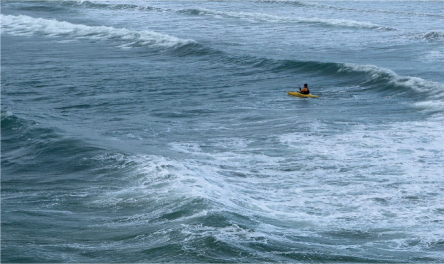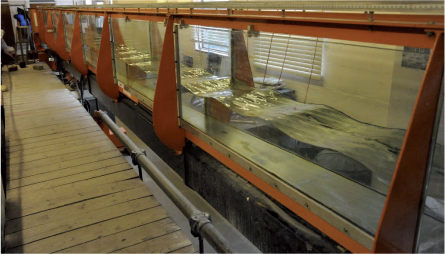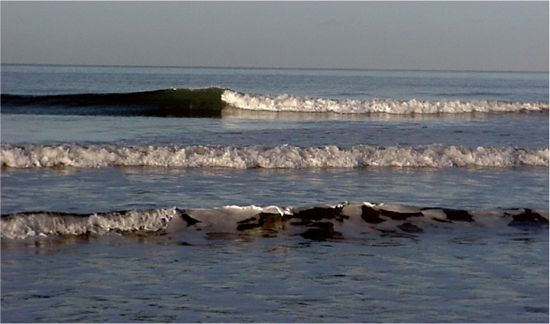3 Ocean waves
Ocean waves are a familiar sight to anyone who has looked at the sea. Waves are important because they may be a hazard to shipping, and they carry energy that has the potential to be harnessed to our benefit. Waves near the beach make swimming in the sea fun, and the whole surfing industry is based on good beach waves.
On a calm day, waves can approach the beach as a regular sequence of parallel humps of water. These waves have travelled from a distant storm, often over many kilometres of ocean, and are called swell waves (Figure 3.1). On more windy days, swell waves can be supplemented by waves generated locally, and which have a more confused pattern, sometimes called ‘sea’ (Figure 3.2).

Figure 3.1 Swell waves arriving at a beach. Waves like this have travelled from a distant storm. Because longer waves travel faster, it is the longest waves from the storm that arrive at the beach first.

Figure 3.2 Waves made in a coastal sea by the action of the wind are short and choppy, often travelling in more than one direction.
3.1 Making waves
Waves can be made in a pond by lobbing in a pebble. The nearest oceanic equivalent to this is a tsunami, which is a wave created by an underwater earthquake. In both the pond and the tsunami, the waves travel outwards from the disturbance into the surrounding water.
Waves can also be created in a channel by moving a paddle back and forth (Figure 3.3). This creates a regular train of waves travelling in one direction that is useful for measuring the effect of waves on, say, sand transport. The most familiar form of water waves, though, is as wind waves, created by the action of the wind on the water surface. It is not easy to understand how an essentially horizontal wind can create vertical waves, but the friction between the air and the water creates a rubbing force in the same way that you can create crinkles in a tablecloth by moving your hand over it.

Figure 3.3 Waves can be created in a long tank (a flume) by oscillating a paddle at one end. The wavelength is the horizontal distance between two crests

Figure 3.3 The wave height the vertical distance between a crest and a trough.
Any water wave has a number of features. The highest point in the wave is called the wave crest and the lowest the wave trough. The vertical distance between the crest and the trough is the wave height. The horizontal distance between two crests is called the wavelength (L). The ratio of wave height to wavelength (called the wave steepness) seems to have a maximum value of about 1/7; waves steeper than this break. If you watch the crest of a wave, it travels along at a speed that is called the phase speed (usually denoted by the symbol c). The time between one crest and the next passing a fixed point is called the wave period (T). Since the wave has travelled exactly one wavelength in this time, it follows that c = L/T.
Below the waves, the water moves in wave-induced currents called orbitals. The speed of the water in these currents is different to the speed of the waves. We will return to the motion of the water in the orbitals in section 3.3.
3.2 Energy in waves
It takes energy to make waves, and the bigger the waves are, the more energy is needed. In fact it can be shown that the energy in waves is proportional to the square of the wave height (Table 3.1). Even moderate waves have a lot of energy, and the energy travels with the waves. There are many ingenious devices for trapping this energy and turning it into useful electricity and pilot and commercial wave energy plants are becoming established. A commercial wave energy plant is in operation on Islay in Scotland.
When the wind blows over the ocean it exerts a frictional force on the water surface.
Table 3.1: The energy in waves is proportional to the square of the wave height.
| Wave height (m) | Energy per unit area Joules m–2 |
| 1 | 1,226 |
| 2 | 4,905 |
| 5 | 30,656 |
| 10 | 122,625 |
| 20 | 490,500 |
There is a rule in physics that says that the work, or energy, done by a force is equal to the force times the distance it moves. If you have a steady wind blowing over the sea, the energy it puts into the sea will therefore be proportional to the distance over which the wind acts upon the water. This distance is called the fetch. The energy in wind waves should therefore be proportional to the fetch. Since the energy is also proportional to the square of the wave height, we might expect that the square of the wave height is proportional to the fetch, or (alternatively) that the wave height is proportional to the square root of the fetch. This indeed seems to be the case (as was realised by Thomas Stevenson, father of Robert Louis). Experimental evidence suggests that:

where H is the wave height in metres, and F is the fetch in kilometres. Using this formula, we can see that in a sea 100 km across, we would expect the largest locally generated waves to have a height of about 8 m. In the Atlantic Ocean, with a fetch of 6000 km, we might get waves up to 50 m high. Waves in the Pacific Ocean, which is wider than the Atlantic and therefore has a greater fetch, could be bigger than this. The largest fetch of all is in the Southern Ocean surrounding Antarctica, which has no end, and therefore a potentially limitless fetch. The waves in the Southern Ocean are notorious and the Antarctic explorer Sir Ernest Shackleton, who made a famous small boat journey across this ocean, gave a vivid account of huge waves in his book South:
‘So small was our boat and so great were the seas that often our sail flapped idly in the calm between the crests of two waves. Then we would climb the next slope and catch the full fury of the gale where the wool-like whiteness of the breaking water surged around us.’
The fetch is an important influence on wave height, but it is not the only one. The wave height will also depend on the strength of the wind, and the time for which it has been blowing (a parameter called the duration in wave forecasting). Modern practical wave forecasting techniques therefore take account of three things: fetch, wind strength and duration. You can find a copy of wave forecasting diagrams in, for example, Oceanography and Seamanship by William G.Van Dorn.
3.3 Wave propogation
Once waves are made, they travel (or propagate) away from the generation area. The way they do this is that the crests and troughs travel along, and the water oscillates back and forth as the wave passes through. It is the shape of the wave that travels. The speed of travel and the way that the water oscillates, depends on how deep the water is compared to the wavelength, so we shall treat the two cases separately.
Deep-water waves
When the water is deep compared to the wavelength, it is observed that water particles go round in almost closed circles (called orbitals) as the waves travel past (Figure 3.4). These circles are largest at the surface, where they have a diameter equal to the wave height. The orbitals get smaller as you go deeper, until one wavelength down they have virtually disappeared. For this reason, submarines can dive to avoid storm waves. The maximum speed of the water movement in the orbitals is equal to the diameter of the largest circle (πH) divided by the wave period. For 1 metre high waves with a period 10 seconds, this is 31 cm s–1. The speed at which the waves travel is much faster. For deep-water waves, it can be shown that the wave speed is proportional to the period (Table 3.2).

Figure 3.4 In deep water, currents beneath the waves move in circular ‘orbitals’ that become smaller with depth. As the waves move into shallow water, the orbitals become flattened. The water now moves backwards and forwards, in the direction of wave travel below the crest and in the opposite direction below the trough.
Table 3.2: For deep-water waves, it can be shown that the wave speed is proportional to the period.
| Wave period (seconds) | Wave speed in deep water or phase speed (m s–1) |
| 1 | 1.56 |
| 2 | 3.12 |
| 5 | 7.80 |
| 10 | 15.6 |
| 15 | 23.4 |
Because waves with long period go faster, and the wavelength is equal to the wave speed times the period, it follows that waves with long wavelength travel faster. When waves are made in a storm, they travel outwards across the ocean, and the longer waves run ahead and separate out. This effect is called wave dispersion. This is the reason why swell waves, arriving at a shore from a distant storm, have such a regular appearance. In travelling across the ocean, waves with different wavelengths separate out. The longest waves arrive at the shore first and gradually, over a period of days, shorter wavelength waves will appear. We can use this effect to work out how far swell waves arriving at a beach have travelled (see text box). You can observe a similar effect on the banks of a river when a speedboat goes past, and the wake arrives on the shore. In this case, the waves hitting the shore will be audible lapping on the shore, and it is noticeable that the time between ‘laps’ gets shorter as time goes on.
Working out how far swell waves have travelled
One day, swell waves with period 15 seconds are observed to arrive on a beach. The next day at the same time, the period of the swell waves has shortened to 10 seconds. How far away is the storm that generated this swell?
The speed of 15 second waves is 23.4 m s–1 (84 km h–1); the speed of 10 second waves is 15.6 m s–1 (56 km h–1). Let the distance to the storm be x km. Since time = distance/speed, and the difference in time between these waves arriving is 24 hours, we have

This can be solved for x (by multiplying both sides by 56 times 84) to show that x is 4032 km. The actual distance travelled is somewhat less than this because of an effect called the group velocity (see main text).
The speed of the waves shown in Table 3.2 is the speed of a wave with exactly the given period – it is called the phase speed. However, swell waves at sea actually consist of a number of waves of similar period travelling together, called a wave group. You can make a wave group in a tank such as that shown in Figure 3.3 by switching the generating paddle on for a few seconds and then switching it off; you will create a group of waves which travel down the tank away from the paddle. If you watch the group carefully you will see that the wave leading the group disappears, and a new one grows at the back. This only happens in deep-water waves. What happens is that the wave energy cannot travel as fast as the phase velocity of the waves – in fact it can only travel half as fast. So the leading waves run out of energy, and this energy is passed to the waves at the back. The speed of travel of the wave group is called the group velocity, and for deep-water waves this is just one half the deep-water wave phase speed. Because of this, the distance to the storm is half as far as we estimated – about 2000 km. If these waves were measured in Britain, they would have come from a storm in the north Atlantic..
Shallow-water waves
When waves move into water that is shallow compared to their wavelength, the orbitals become squashed. Now, as the wave goes past, the water particles oscillate backwards and forwards almost horizontally (Figure 3.4). Under the crest of the wave, the current flows in the same direction as the wave, and under the trough it travels in the opposite direction. The strength of the current increases with wave height and increases as the water gets shallower. For these shallow-water waves both the phase speed (that is the speed at which the crest advances) and the group velocity (the speed at which the wave energy advances) are the same and depend only on the water depth. The speed can be calculated from the formula

where c is the wave speed (in metres per second), g is the acceleration of gravity and D is the water depth (in metres). Some wave speeds in different water depths are shown in the table. You may wonder why a depth of 4000 m is included for shallow-water waves. Remember, we are talking about water that is shallow compared to the wavelength, and for very long waves (tides and tsunamis) even the deep ocean can appear shallow. Notice that these waves can travel very fast. We have included in this table the maximum current speed under the wave assuming the wave is 1 m high. (For other wave heights, multiply these figures for the maximum current speed by the wave height, so for 2 m waves, you would double these figures). Notice that the current speed is usually much less than the wave speed, but in fact the two become equal when the water depth is about the same as the wave height. At this point the currents in the wave are going as fast as the wave is travelling, and the wave tends to break (Figure 3.5).
Table 3.3: Relationship between depth, wave speed and maximum current for shallow-water waves.

3.4 Waves near the shore
The fact that, in shallow water, the wave speed just depends on the water depth leads to a number of interesting phenomena, one of which is refraction. If waves approach a shore at an angle, the part of the wave crest closest the shore travels more slowly than that further offshore, and as a result the wave crest becomes curved. The angle that the crest makes with the shore obeys a law from optics called Snell’s Law. This says that the sine of the angle the crest makes with the shore divided by the speed of the wave is a constant. As the waves move into shallow water and their speed reduces, so does the sine of the angle between the crest and the shore.

Figure 3.5 Waves approaching the shore tend to break when the wave height is about the same as the water depth. In this photograph, the height of the wave at the back is seen to increase from left to right (because the water is getting shallower in this direction) and the wave breaks at a point where the ratio of the wave height to the water depth reaches a critical value.

Figure 3.6 Surfing in breaking waves on the coast of Brittany, France. Surfers ride on the face of the breaking wave, where the lift provided by the current flowing towards the crest is sufficient to support their body weight.
Another effect of the waves slowing down as they approach the shore is that they get bigger. Conservation of energy requires the product of the wave speed and the energy in the wave to be a constant. As the speed gets less, the energy must increase, and this means that the wave height increases. This continues until the wave breaks and gives up its energy.
Surfers like to ride waves that are just on the point of breaking and remain so for a long time. A flat beach is best from this point of view, and this sort of beach tends to produce spilling waves. There is a position on the face of the wave that is stable in the sense that the weight of the surfer down the wave face is just balanced by the current moving towards the crest (Figure 3.6). It is a feature of breaking waves that the current is close to the wave speed itself.